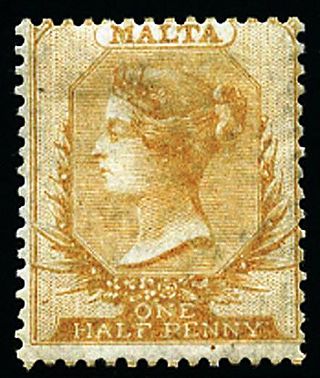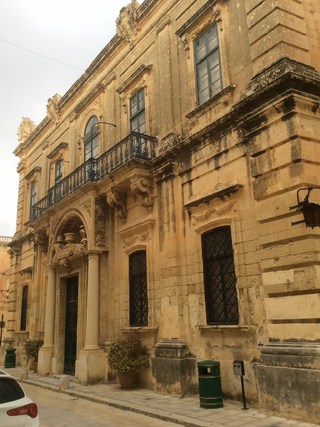The General Post Office was the British postal system from 1660 until 1969.

António Manoel de Vilhena was a Portuguese nobleman who was the 66th Prince and Grand Master of the Order of St. John of Jerusalem from 19 June 1722 to his death in 1736. Unlike a number of the other Grand Masters, he was benevolent and popular with the Maltese people. Vilhena is mostly remembered for the founding of Floriana, the construction of Fort Manoel and the Manoel Theatre, and the renovation of the city of Mdina.

Maltese architecture has its origins in prehistory, and some of the oldest free-standing structures on Earth – a series of megalithic temples – can be found on Malta. The islands were colonized by the Phoenicians and later the Romans, who established the cities of Melite and Gaulos. Although these were substantial settlements and are known to have had numerous temples, churches and palaces, few remains have survived apart from some architectural fragments.

The Castellania, also known as the Castellania Palace, is a former courthouse and prison in Valletta, Malta that currently houses the country's health ministry. It was built by the Order of St. John between 1757 and 1760, on the site of an earlier courthouse which had been built in 1572.

The postal history of Malta began in the early modern period, when pre-adhesive mail was delivered to foreign destinations by privately owned ships for a fee. The earliest known letter from Malta, sent during the rule of the Order of St John, is dated 1532. The first formal postal service on the islands was established by the Order in 1708, with the post office being located at the Casa del Commun Tesoro in Valletta. The first postal markings on mail appeared later on in the 18th century.
This page list topics related to Malta.

Republic Square is a piazza in Valletta, Malta. The square was originally called Piazza Tesoreria or Piazza dei Cavallieri, since the treasury of the Order of Saint John was located in the square. After a statue of Queen Victoria was installed in the square in the 19th century, it became known as Queen's Square or Piazza Regina. Although its official name is Republic Square, it is still commonly referred to as Piazza Regina.

This is an article about the postage stamps and postal history of the Sovereign Military Order of Malta.

The Auberge d'Auvergne was an auberge in Valletta, Malta. It was built in the 16th century to house knights of the Order of Saint John from the langue of Auvergne. It became a courthouse in the 19th century, and it remained so until it was destroyed by aerial bombardment in 1941. The site is now occupied by the Courts of Justice building, which was constructed in the 1960s.

Vilhena Palace, also known as the Magisterial Palace and Palazzo Pretorio, is a French Baroque palace in Mdina, Malta. It is named after António Manoel de Vilhena, the Grand Master who commissioned it. It was built between 1726 and 1728 to designs of the French architect Charles François de Mondion, on the site of the meeting place of the Università. The palace was used a hospital in the 19th and 20th centuries, and it became known as Connaught Hospital after 1909. Since 1973, it has been open to the public as Malta's National Museum of Natural History.

Palazzo Parisio, sometimes known as Casa Parisio, is a palace in Valletta, Malta. It was built in the 1740s by Domenico Sceberras, and eventually passed into the hands of the Muscati and Parisio Muscati families. It was Napoleon's residence for six days in June 1798, during the early days of the French occupation of Malta. The palace was eventually acquired by the de Piro family, and was later purchased by the Government of Malta. It was used as the General Post Office from 1886 to 1973, then the Ministry for Agriculture, and it now houses the Ministry for Foreign Affairs.

The Banca Giuratale, formerly also known as Banca dei Giurati, the Municipal Palace, the Palazzo della Città, Casa Città and the Consolato del Mare, is a public building in Valletta, Malta. It was built in the 18th century to house the city's administrative council, and it was subsequently used as the General Post Office and the Public Registry. The Banca Giuratale now houses the Ministry for the Economy,Enterprise and Strategic Projects, and it is officially known as Palazzo Zondadari.

The Banca Giuratale, also known as the Municipal Palace, is a public building in Mdina, Malta. It was built in the 18th century to house the city's administrative council and courts, and was later used as a private residence and a school. It now houses part of the National Archives of Malta.

The Banca Giuratale is the city hall of Victoria, Gozo, Malta. It was built in the 18th century as the seat of the Università of Gozo. Over the years, it housed several government departments and also served as a police station and a post office. The building is currently the seat of the Victoria Local Council and the Gozo Regional Committee, and also houses the culture and information sections of the Ministry for Gozo.

The Corte Capitanale is a former courthouse in Mdina, Malta, which currently serves as a city hall. It was built in the Baroque style between 1726 and 1728, to designs of the French architect Charles François de Mondion. The building is linked to Palazzo Vilhena, but it has its own entrance and façade.

The Casa del Commun Tesoro, or Casa dei Conti del Tesoro, is a building in Valletta, Malta, located in Republic Square facing the Bibliotheca. It was originally built to house the Treasury of the Order of St. John. Part of the building housed Malta's first post office, and over the years it was also used as government offices, a hotel and a cinema. Since the early 20th century, it has been the premises of a gentlemen's club known as the Casino Maltese.

The Monte di Pietà, formerly known as the Monte di Sant'Anna, is a charitable institution which lends money to those in need at modest interest rates, on the security of gold, silver or other precious articles given in pawn. In Malta the institution was set up in 1598, was known in the British period as the Public Pawn-Brokery, and it is still in operation today as part of the Inland Revenue Department. Since 1773, the Monte di Pietà has been housed in a 16th-century building in Valletta.

Admiralty House, formerly known as Casa Miari, Palazzo Don Raimondo and by several other names, is a palace in Valletta, Malta. It was originally built in 1569–70 as two private houses by Fra Jean de Soubiran dit Arafat, a knight of the Order of St. John. The houses were later leased to various owners, including Fra Raimondo de Sousa y Silva, who rebuilt them a single residence between 1761 and 1763.

Maltese Baroque architecture is the form of Baroque architecture that developed in Malta during the 17th and 18th centuries, when the islands were under the rule of the Order of St. John. The Baroque style was introduced in Malta in the early 17th century, possibly by the Bolognese engineer Bontadino de Bontadini during the construction of the Wignacourt Aqueduct. The style became popular in the mid to late 17th century, and it reached its peak during the 18th century, when monumental Baroque structures such as Auberge de Castille were constructed.
Romano Fortunato Carapecchia (1666–1738) was an Italian Baroque architect who was active in Rome, Malta and Sicily. His designs helped transform Malta's capital Valletta into a Baroque city in the first few decades of the 18th century.



















